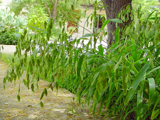Native Plants

Q. Who is Mr. Smarty Plants?
A: There are those who suspect Wildflower Center volunteers are the culpable and capable culprits. Yet, others think staff members play some, albeit small, role. You can torture us with your plant questions, but we will never reveal the Green Guru's secret identity.
Did you know you can access the Native Plant Information Network with your web-enabled smartphone?
Ask Mr. Smarty Plants is a free service provided by the staff and volunteers at the Lady Bird Johnson Wildflower Center.

rate this answer
Friday - May 28, 2010
From: Wichita, KS
Region: Midwest
Topic: Grasses or Grass-like
Title: Advice on grasses under walnut trees
Answered by: Nan Hampton
QUESTION:
Little advice on grasses: I am prepared to plant zoysia under two walnut trees. Forgot about juglone-is this a good idea?ANSWER:
All members of the Family Juglandaceae (Walnut Family), including pecan, butternut and hickory trees as well walnuts, produce and release a chemical called juglone to defend their growing space against encroachment by other plants. The amount or strength of the juglone released varies among the different species of the family. I don't know which walnut trees you have, Juglans nigra (black walnut tree) or Juglans microcarpa (little walnut), but black walnut is reported to have the most, or at least, the most effective juglone. With this defense mechanism, called allelopathy, the tree adversely affects many other (but not all) plants. Juglone can be found in all parts of the black walnut tree. If the roots of another plant come within 1/2 inch of the walnuts roots, they can absorb the juglone and sicken and die. Also, walnut leaf litter and walnut fruit on the ground leach juglone into the soil. Virginia Extension Service has an excellent discussion of the black walnut and its allelopathic effects. Additionally, the article lists common plants that are affected by the juglone of the walnut. There is also a list of plants that will grow near the black walnut. There are other lists of plants affected by and/or tolerant of juglone (e.g., Cornell Cooperative Extension and University of Wisconsin Extension) but all of them are rather short on any grasses on the list.
A search for "zoysia" and "walnut or juglone" gave contradictory results with some evidence that juglone affected the grass and other evidence suggesting it was as much the shade as the juglone that was the culprit. This is sort of all beside the point, however, because Mr. Smarty Plants wouldn't recommend zoysia in the first place since it is native to Asia and Australasia and what we are all about here at the Wildflower Center is "to increase the sustainable use and conservation of native wildflowers, plants and landscapes"
I can, however, offer some substitutes. There are no native turf grasses that do well in the shade, but there are a few possibilities for ground covers that are shade-loving and juglone resistant. Here are a few:
Chasmanthium latifolium (Inland sea oats) is an attractive clumping grass that loves the shade and isn't affected by juglone. (This is a personal observation since I have a large population of inland sea oats growing under my black walnut tree and it has grown there for several years). Here is more information.
Sedges are resistant to the effects of juglone and they grow well in the shade. Carex blanda (eastern woodland sedge) is native to Kansas and would make a good ground cover. Here is more information and photos of Carex blanda.
Ferns are also resistant to juglone and grow well in the shade. Here are some suggestions native to Kansas:
Asplenium platyneuron (ebony spleenwort) and here is more information.
Onoclea sensibilis (sensitive fern) and here is more information.
More Grasses or Grass-like Questions
Tilling for grass under old live oak in San Antonio
April 15, 2012 - Hi,
I have a 250+ year old Texas Live Oak. As usual, the lawn under the tree, after 18 years needs to be redone. MY QUESTION: to put down new sod the lawn company needs to till the soil about 4 t...
view the full question and answer
Native plants for roadside in Gallatin TN
February 19, 2012 - What native plant would you suggest that we try to establish on 100 feet of road frontage which gets full afternoon sun? The soil is mostly clay, and it's on a rather sleep hill about 10 feet high. ...
view the full question and answer
Planting creeping phlox for a groundcover
June 13, 2014 - Dear Mr. Smarty Plants,
I live in Southwestern PA (zip code 15065). I have a small slope on my property that is hard for me to mow. I would like to cover it with creeping phlox, which I saw on t...
view the full question and answer
Plants to prevent creekside erosion in Nacogdoches County, Texas
December 09, 2014 - I am looking for some advice on plants native to Texas that can help prevent erosion. I own a wooded lot with a creek and would like to consolidate the sides of the creek against potential erosion. I...
view the full question and answer
Type of clumping bamboo for outdoor planters from Plano TX
March 25, 2014 - What type of clumping bamboo can be grown outdoors in planters in Dallas,TX?
view the full question and answer
| Support the Wildflower Center by Donating Online or Becoming a Member today. |

